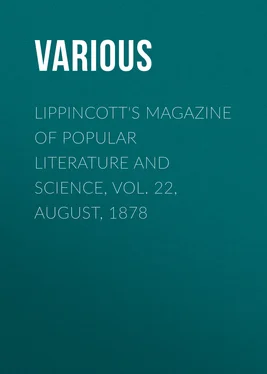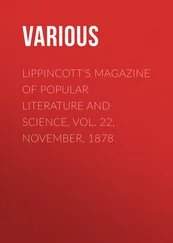Various - Lippincott's Magazine of Popular Literature and Science, Vol. 22, August, 1878
Здесь есть возможность читать онлайн «Various - Lippincott's Magazine of Popular Literature and Science, Vol. 22, August, 1878» — ознакомительный отрывок электронной книги совершенно бесплатно, а после прочтения отрывка купить полную версию. В некоторых случаях можно слушать аудио, скачать через торрент в формате fb2 и присутствует краткое содержание. Издательство: Иностранный паблик, Жанр: foreign_antique, periodic, foreign_edu, на английском языке. Описание произведения, (предисловие) а так же отзывы посетителей доступны на портале библиотеки ЛибКат.
- Название:Lippincott's Magazine of Popular Literature and Science, Vol. 22, August, 1878
- Автор:
- Издательство:Иностранный паблик
- Жанр:
- Год:неизвестен
- ISBN:нет данных
- Рейтинг книги:4 / 5. Голосов: 1
-
Избранное:Добавить в избранное
- Отзывы:
-
Ваша оценка:
- 80
- 1
- 2
- 3
- 4
- 5
Lippincott's Magazine of Popular Literature and Science, Vol. 22, August, 1878: краткое содержание, описание и аннотация
Предлагаем к чтению аннотацию, описание, краткое содержание или предисловие (зависит от того, что написал сам автор книги «Lippincott's Magazine of Popular Literature and Science, Vol. 22, August, 1878»). Если вы не нашли необходимую информацию о книге — напишите в комментариях, мы постараемся отыскать её.
Lippincott's Magazine of Popular Literature and Science, Vol. 22, August, 1878 — читать онлайн ознакомительный отрывок
Ниже представлен текст книги, разбитый по страницам. Система сохранения места последней прочитанной страницы, позволяет с удобством читать онлайн бесплатно книгу «Lippincott's Magazine of Popular Literature and Science, Vol. 22, August, 1878», без необходимости каждый раз заново искать на чём Вы остановились. Поставьте закладку, и сможете в любой момент перейти на страницу, на которой закончили чтение.
Интервал:
Закладка:
THE ENGLISH QUARTER, ON INTERNATIONAL AVENUE.
The cascade of the Trocadéro has nothing meretricious about it. It is, like the building of which it is the finest ornament, of Jura marble, while much of the adjacent work is of artificial stone so admirably made that one cannot tell the difference, and is disposed to give the preference to the latter as evincing greater ingenuity than the mere patient chiselling of the quarry-stone. The pools are symmetrical, in conformity to the style of their surroundings, their overflows curved, the successive falls being about two feet after the first dash nine hundred and twenty feet from the balcony level. Each side of the cascade is flanked by six small pools in which are spouting and spray jets. The course ends in a pool which may be described as square, with circular bays on three of its sides. In this are one large jet and two smaller ones, which are themselves beautiful and keep the surface in a pleasant ripple. The corner pillars are crowned by colossal gilt figures of animals, supposed to represent what we were used to call the "four quarters of the earth"—Europe, Asia, Africa and America, as the books had it before America had attained any prominence in public estimation. These are typified by a horse, an elephant, a rhinoceros and a bull, the latter probably a tribute to our bison, but not much like him. These face the four winds, so to speak, and do indeed more nearly, as they are set obliquely, than do the grounds and buildings, the length of which runs north-west and south-east. Each animal has his back to the pool, and with one exception is in a rampant attitude.
Many thousands of cubic mètres of stone were quarried away to afford a site for the cascade, for the system of water-pipes which supply the various pools and jets and conduct off the surplus. The size of the site occupied by these hydraulic works is 360 by 75 feet.
The balcony of the Trocadéro facing toward the river and the Champ de Mars affords the most extensive view obtainable in the grounds. Beneath is the cascade with its basins and fountains, and spreading away on each side is the garden with its various national buildings, neat, gaudy or grotesque. Spanning the invisible roads and river is the broad Pont d'Iéna, and then comes a repetition of the garden, the sward dotted with parterres and buildings. A broad terrace, crowned with the splendid façade of the main building, does not quite terminate the view, for from the height of the lower corridor of the rotunda the buildings of Paris are seen to stretch away in the distance. The hill of Montmartre on the north and the heights of Chatillon and Clamart on the south terminate the view in those directions.
The cascade immediately beneath us has been already described, but how shall we give an impression of the appearance of the buildings collected in groups on each side of the main avenue? So great is the variety of objects to be presented that any very large unbroken surface of sward is impossible. The general plan is geometrical, and the absence of large trees on the newly-made ground has prevented any attempt at woodland scenery.
The French make great use of common flowers in obtaining effects of color. Some square beds of large size have centres of purple and white stocks, giving a mottled appearance, with a border of the tender blue forget-me-nots and a fringe of double daisies. Other beds are full of purple, red and white anemones, multicolored poppies or yellow marigolds. The sober mignonette is too great a favorite to be excluded, though it lends little to the effect. The gorgeous rhododendron is here massed in large beds, and there forms a standard tree with a formal clump of foliage and gay flowers, contrasting with the bright green of the succulent grass. The roses are by thousands in beds and lining the walks, and here are especially to be seen the standard roses for which Europe is so famous, but which do not seem to prosper with us.
Besides the flowers and flowering shrubs, a most profuse use is made of evergreens, which are removed of surprising size and forwardness of spring growth. We can form little conception from our gardens at home of the wealth, variety and exuberance of the evergreen foliage in Southern England and Northern France—the Spanish and Portuguese laurel, laurustinus, arbutus, occuba, bay, hollies in variety, tree-box, with scores of species of pines, firs, arborvitæ and yews, relieved by the contorted foliage of the auraucarias, the sombre cedar of Lebanon and the graceful deodar cedar of the Himalayas. As already remarked, the tree-growth is small, as the ground was a blank and rocky hillside two years ago, and was quarried to make a site for the garden. The tree which seems best to bear moving, and is consequently used in the emergency, is the horse-chestnut, the red and white flowering varieties being intermingled. This is perhaps the most common tree in the streets of Paris, though the plane and maple are also favorites.
BIRD'S-EYE VIEW OF THE MAIN BUILDING AND ITS SURROUNDINGS.
Against the rocky scarp on the south of the garden a plantation of aloes, yuccas and cactus has been made. These are in great variety, and some of them in flower. It was especially pleasant to see the independence which the gardener has shown in placing a fine clump of rhubarb in one place where he wanted a green bunch. Some persons would have been afraid of injurious criticism in the use of so common a plant, but we all know what a vigorous, healthy green it is, and as such not to be despised by the artist in color. There are a few specialties in the way of gardening which are worth notice: one is the array of tulips planted by the city of Haarlem, and representing the municipal coat-of-arms in tulips of every imaginable color of which the plant is capable, and around the figures the words "Haarlem, Holland," in scarlet tulips on a ground of white ones.
Another novelty is the Japanese garden with its bamboo fence, the posts and door of entrance being carved with remarkable taste and boldness. The double gates are surmounted by a cock and hen in natural attitudes, which is a relief from the absurdities of their impossible storks and hideous griffins. Perhaps it shows that modern and European ideas are at work there. The flag of Japan, by the way—a red circle on a white ground—is a sensible design, and can be seen at a distance: it contrasts favorably with the dragon on a yellow ground of the Chinese pavilion. The Japanese garden has several large standard umbrellas for permanent shade, and little bamboo-fenced yards for the game chickens and the ducks. Two shrines are in the garden, and a fountain with a feeble jet issuing from a stump and falling into a little fanciful pond with small bays and promontories. On the miniature deep a walnut-shell ship might ride, and on the shoals near the bank aquatic plants are beginning to sprout, and their leaves will soon touch the opposite shore if they are not attended to.
Rather a disparagement, as a matter of taste, to the somewhat formal grace but undoubted beauty of this floral scene are the buildings which are placed here and there over the surface. However, it is these that we have come to see, for if we were in search of landscape or Dutch gardening we should find it better elsewhere. This gardening is only a setting, a frame, in which the various nations have set up their cottages and villas. The ground surface between the houses has been laid off ornamentally to please the eye and satisfy the sense of order and beauty, but is not itself the object of which we are in search. It is impossible perhaps to harmonize such an incongruous set of buildings, adapted for different climates, habits, tastes and needs. Here on the left is a large white castellated house of Algiers. It has blank walls and loopholed towers, and no suggestion of a tree or flower, but gives an idea of the land where the sand of the desert comes up to the doorstep and beggars and thieves go on horseback. On the opposite extremity, at the right, is a Chinese house with its peculiar curved roof, suggested originally, doubtless, by the Tartar tent, but having more curves and points than were ever shown by canvas or felt. In a district by themselves the readers of the Koran—or a set of people passing for such—have their Persian, Tunisian, Morocco and Turkish kiosques, and the inhabitants seem perhaps one shade cleaner than they did in Philadelphia. They are supposed, at least, to be the same, and have an exactly similar lot of rubbish and brass jewelry for sale, and oil of cassia, which they sell for the attar of the "gardens of Gul in their bloom." Next is a campanile of Sweden, and near it are the Swedish and Norwegian houses, armed against winter. Then the Japanese cottage with sides all open, mats on the floors and no furniture to speak of. Then comes a Moorish pavilion of Spain with nondescript ornaments, the bulbous domes and pinnacles supporting the flags of yellow and red—of barbaric taste, color and significance.
Читать дальшеИнтервал:
Закладка:
Похожие книги на «Lippincott's Magazine of Popular Literature and Science, Vol. 22, August, 1878»
Представляем Вашему вниманию похожие книги на «Lippincott's Magazine of Popular Literature and Science, Vol. 22, August, 1878» списком для выбора. Мы отобрали схожую по названию и смыслу литературу в надежде предоставить читателям больше вариантов отыскать новые, интересные, ещё непрочитанные произведения.
Обсуждение, отзывы о книге «Lippincott's Magazine of Popular Literature and Science, Vol. 22, August, 1878» и просто собственные мнения читателей. Оставьте ваши комментарии, напишите, что Вы думаете о произведении, его смысле или главных героях. Укажите что конкретно понравилось, а что нет, и почему Вы так считаете.












